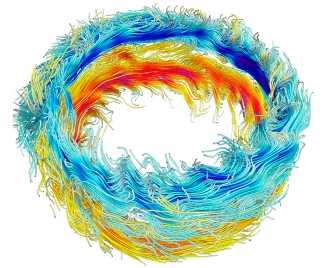The researchers also found global-scale circulations between the star’s poles. In solar dynamo theories, such circulations act as a conveyor belt that helps transport magnetic fields through the convection zone to the tachocline, the transition region between the Sun’s convective zone and its radiative interior. Scientists believe that the tachocline is the seat of the solar dynamo and that magnetic fields bubble up from this region to erupt at the surface as sunspots.
When Brown and his colleagues looked at global-scale convection in a Sun-like star with a rotation period of about three days, they found interesting convective patterns on the star’s surface. Narrow "nests of convection" appeared, and the convective motions near the equator were confined to small intervals in longitude. These nests spanned the convection zone, lasted for thousands of days, and persisted in the presence of magnetic fields — an important feature since our own Sun is a magnetic star.
The researchers also found global-scale circulations between the star’s poles. In solar dynamo theories, such circulations act as a conveyor belt that helps transport magnetic fields through the convection zone to the tachocline, the transition region between the Sun’s convective zone and its radiative interior. Scientists believe that the tachocline is the seat of the solar dynamo and that magnetic fields bubble up from this region to erupt at the surface as sunspots.
In the Sun, the conveyor belt consists of two giant cells, one in each hemisphere. Most stellar dynamo theories assume that similar circulations exist in other stars and are actually stronger when the star is younger and rotating more rapidly. However, Brown and his colleagues found the circulations to be weaker and slower than expected. And, instead of two giant cells, the circulation patterns consisted of multiple small cells.
The findings raised questions for stellar dynamo theory. Since small, weak circulation cells would have difficulty transporting magnetic fields down to the stellar tachoclines, "starspot" cycles would be unlikely to occur in younger suns. However, they are actually observed in young, magnetically active stars.
Faced with this conundrum, Brown and his colleagues decided to run more detailed simulations that included magnetic fields. Surprisingly, they found that large-scale magnetic fields were created throughout the convection zone of young, rapidly spinning stars. These fields were organized into large wreaths with different polarities above and below the equator. Surprisingly, these large structures were not shredded apart by the star’s turbulent convection. In fact, these fields could easily become starspot at the surface of the young star.
The unexpected behavior of the stellar magnetic fields is shedding new light not only on how the solar dynamo functioned in the past, but also how it works today. Until now, researchers believed that the global-scale solar dynamo was rooted in the tachocline rather than residing within the convection zone itself. Now it appears that it might operate in both locations simultaneously. As Brown said, "We started out to investigate what might happen in young stars that rotate rapidly, and along the way, we’ve stumbled into a deeper understanding of the dynamo inside our Sun." - Julie Phillips





